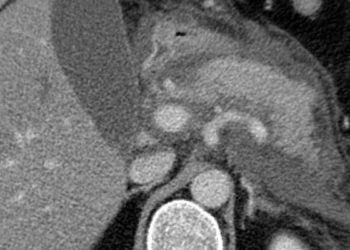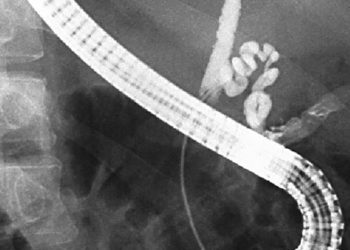Magnetic resonance cholangiopancreatography diagnoses bile duct obstruction with high sensitivity and specificity [Classics Series]
This study summary is an excerpt from the book 2 Minute Medicine’s The Classics in Medicine: Summaries of the Landmark Trials
1. Magnetic resonance cholangiopancreatography (MRCP) diagnosed bile duct obstruction with high sensitivity and specificity when compared to invasive endoscopic retrograde cholangiopancreatography (ERCP).
2. MRCP was highly specific but less sensitive in identifying causes of bile duct obstruction such as malignancy or choledocholithiasis.
Original Date of Publication: October 1995
Study Rundown: Ultrasound and computed tomography have long been used in the noninvasive diagnosis of biliary obstruction, though are limited by their low sensitivity in detecting common bile duct (CBD) stones. ERCP involves endoscopically accessing the pancreatic ducts and biliary tree and directly visualizing them via injection of iodinated contrast, allowing sensitive detection of stones and other pathology as well as the capability for direct therapeutic intervention if necessary. Its invasive nature, however, remains a limitation. MRCP was created to allow noninvasive evaluation of the biliary tree using magnetic resonance imaging. In the study conducted by Guibaud and colleagues, MRCP was compared to ERCP in the diagnosis of bile duct obstruction. The results of this study demonstrated that MRCP can be used in diagnosing bile duct obstruction with high specificity and sensitivity, with few false negative results. MRCP was also able to correctly identify choledocholithiasis or malignancy as causes of obstruction with high specificity and acceptable sensitivity, informing its subsequent increasing use as a reliable noninvasive tool in the workup of biliary obstruction.
Click to read the study in Radiology
In-Depth [prospective cohort]: All patients with clinically suspected bile duct obstruction were referred for evaluation and consecutively screened for enrollment (n=206). Patients were excluded if direct cholangiographic, histopathological or surgical proof of bile duct obstruction could not be obtained, ERCP was unsuccessful, MRCP could not be performed due to claustrophobia, or if the results of either technique were inadequate. All patients included in the study underwent MRCP with heavily T2-weighted fast spin-echo sequences. All MR images were evaluated by 2 reviewers without knowledge of clinical parameters or results of other imaging studies. The final diagnosis and, where applicable, the cause of bile duct obstruction, was determined through ERCP. The following diagnoses were considered causes of obstruction: CBD stones, malignant obstruction, chronic pancreatitis, intrahepatic stones and distal obstruction from an undetermined cause. ERCP and MRCP were successfully performed in a total of 126 patients (mean age 57 years, range 12-91 years; 40% male). Based on the reference standard, 79 patients (63%) were found to have bile duct obstruction. Among these patients, MRCP correctly diagnosed bile duct obstruction in 72 patients, yielding a sensitivity of 91% (95%CI 85-100%) and specificity of 100%. In addition, MRCP correctly diagnosed malignancy as a cause of obstruction in 12 out of 14 patients, corresponding to a sensitivity of 86% (95%CI 67-100%) and specificity of 98% (95%CI 96-100%). In diagnosing choledocholithiasis as a cause of obstruction, the sensitivity of MRCP was less at 81% (95%CI 68-95%), with a specificity of 98% (95%CI 95-100%).
Guibaud L, Bret PM, Reinhold C, Atri M, Barkun AN. Bile duct obstruction and choledocholithiasis: diagnosis with MR cholangiography. Radiology. 1995 Oct;197(1):109-15.
©2022 2 Minute Medicine, Inc. All rights reserved. No works may be reproduced without expressed written consent from 2 Minute Medicine, Inc. Inquire about licensing here. No article should be construed as medical advice and is not intended as such by the authors or by 2 Minute Medicine, Inc.




![The ABCD2 score: Risk of stroke after Transient Ischemic Attack (TIA) [Classics Series]](https://www.2minutemedicine.com/wp-content/uploads/2013/05/web-cover-classics-with-logo-medicine-BW-small-jpg-350x250.jpg)


